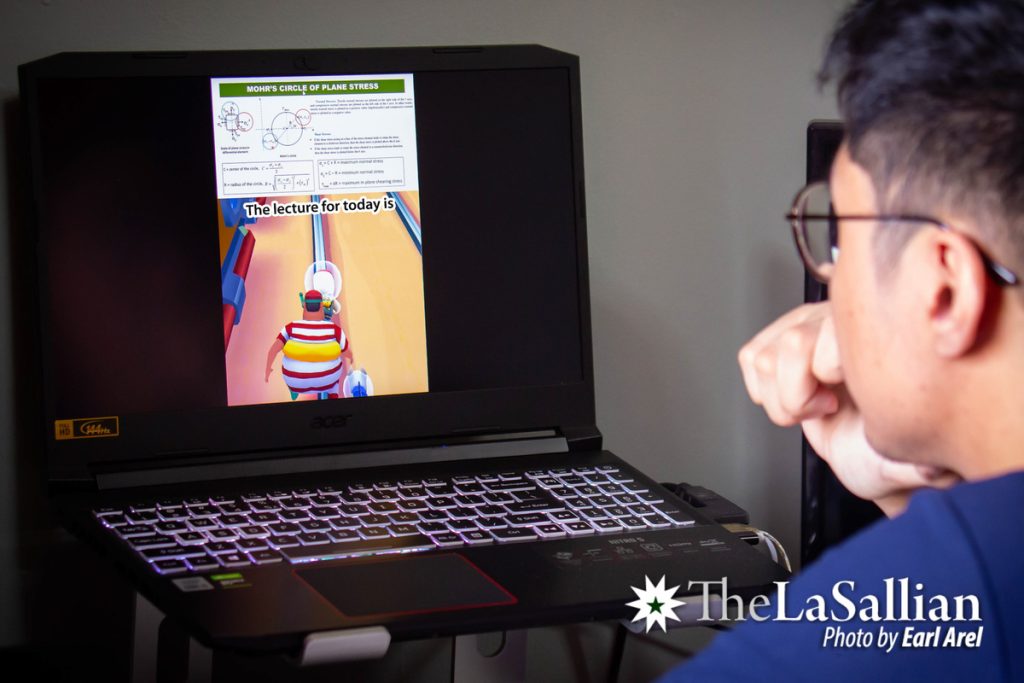In human history, the development of avant-garde and revolutionary learning techniques has always gone hand-in-hand with the advancement of technology. Lessons had been taught using different methods stemming from different eras. For our ancestors, it was the abacus; for the current generation, it is the rising TikTok trend of sludging.
The practice of sludging, or stitching together serious videos with clips of people playing random games, is now a defining feature of the aforementioned social media platform. It is only recently—since the viral video of a student who was able to code for eight hours straight by split-screening his coding project and Temple Run gameplay—that it has been taken as a valid form of learning. And now, it is one that has been adopted by our very own University.

Slime, sand, and parkour
“Innovative, amazing, and fresh!” Dr. Kaihion Kalibangon, a professor under the School of Influence and Showbiz (SIZ) exclaims enthusiastically about the trend. “Now with this system in place, none of my students will ever want to fall asleep in class again!”
Kalibangon proudly shares that his 16-year-old daughter was the one who introduced him to this teaching strategy. “I was able to watch a whole movie on TikTok with her in 518 parts,” he shares excitedly. “And it was all the while watching a video gameplay of someone beating Subway Surfers!”
He uses this system now for his biochemistry lectures, citing that his students now participate more in class and watch all of his videos, “even the ones about carbohydrate catabolism!” The professor makes sure to point out that a large variety of clips can be paired with the actual lessons, such as kinetic sand-playing and slime mixing. “It really is amazing what the kids come up with, these days,” he says, completely impressed. “Such a giving slay!”
Dr. Permi Makalimutan, full professor in the College of Science and celebrated neuroscientist, furthers that this trend is supported by research and scientific basis. “A study done by Harvard showed that there is a 35-percent boost in student productivity when lectures are accompanied by Minecraft parkour videos and an astonishing 60-percent rise when accompanied by fidget toy testing videos,” Makalimutan shares. “In fact, one of my thesis advisees accomplished writing the entirety of their paper in four days by split-screening their manuscript and Family Guy episodes!”
Makalimutan warns, however, that this method of learning possesses a damning side effect: the loss of proper attention spans. “Brain scans of patients who use this learning method exhibit smaller frontal lobes than those who don’t,” Makalimutan cautions. It has also been shown in the study that patients who rely on these split-screen clips now lack the ability to properly focus on anything without video aid. But to this, Kalibangon scoffs and says, “Who cares? It’ll take a split-screen of the whole season of South Park to get me, or anyone else, to read that paper, anyway.”
While the implementation of this system has accomplished its goal of catching students’ and professors’ attention, University opinion has been largely divided, with some praising this learning format and others lamenting its establishment.
Split(screen) opinions
It goes without saying that the Lasallian students have their own views on the system as well. “This new format has like, changed my life, cleared my skin, watered my crops, and kwatro-fied my GPA,” shares Chaser Ofclout, a (III, BSIG), stating that the trend has changed their entire view on learning. “Like, sa readings and lectures kasi before it was, like, hindi kaya ng attention span ko ‘yun, bro!”
(Like, because for readings and lectures before, my attention span couldn’t handle that, bro!)
However, the trend certainly isn’t everyone’s cup of tea. For Kate Geeper (I, BAGGG), the new format is just “perpetuating students’ overstimulation.” “Like, let’s be for real, I literally don’t think the students even have attention spans at this point,” Geeper says. “As if the TikTok phone stands across campus weren’t enough to flush our brains into a dopamine addiction.” Geeper reckons that, instead of encouraging students to utilize the system, the administration should instead be promoting a “dopamine detox” by banning the use of personal gadgets on campus premises. “We have to go back to the old days,” she asserts. “This is why boomers hate us!”
Still, there’s a case to be made to at least give students the choice to adopt this new learning strategy. Several students have expressed that upon the introduction of the system, they have become less likely to take until 11:59 pm to submit their projects. “My best friend hates it—she’d rather hole up in the library carrying textbooks heavier than gym weights, and I love that for her,” explains Aina Katulog, (VI, BSCPE).
But Katulog recognizes the differences between students’ learning styles and aptitudes, stating that she truly prefers staying up until 3 am to cram her projects. “So what if I need a 200-part coding tutorial mish-mashed with Subway Surfers gameplay to achieve a 4.0?” Katulog challenges.
Intellectualizing the ‘for you page’
While further rules and regulations for its implementation have yet to be ironed out, the DLSU community has proven that the new resource format has revolutionized the learning experience for countless Lasallians. Following this, DLSU has already drafted plans for its adoption in all schools of De La Salle Philippines. Eventually, through advocating the use of this strategy, DLSU aims to be the pioneer of a sludge content system that will be a staple not only throughout Philippine universities but also educational institutions all over the world.
It is without a doubt that as entertainment and culture change, our habits and preferences change along with it. Evidently, humanity has gone a long way from spreading information by word of mouth, to handwriting on leaves, to the printing press, and now, to 30-second screens split between two vastly different forms of media. Only time will tell if, in the future, we’ll be needing 15-second videos instead, with one screen split into four.



